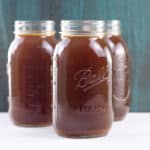Lobster Stock
Rich, flavorful lobster stock is easy and relatively quick to make from leftover lobster shells. Use it for bisque, risotto, and more.
Ingredients
- Shells of eight lobsters along with bodies, if available (see notes section below for prep instructions)
- ½ cup (120 ml) safflower oil
- 2 medium yellow onions trimmed and quartered
- 4 medium carrots trimmed and quartered
- 4 ribs celery including any leaves, trimmed and quartered
- 4 large garlic cloves smashed
- 2 tablespoons (60 grams) tomato paste
- 2 cups (475 ml) dry white wine
- 20 cups 4.7 liters water
- 8 medium thyme sprigs including stems
- 2 large bay leaves
- 12 black peppercorns
- 1 tablespoon fine sea salt optional
Instructions
- Preheat oven to 400°F with a rack in the center.
- Place the prepared shells (but but not yet the bodies) into a large roasting pan. Pour in the oil and toss to coat evenly.
- Roast until quite pale and beginning to brown, about an hour.
- Stir in the onion, carrot, and celery and return to oven. Roast until vegetables are beginning to brown, about 40 minutes.
- Stir in the garlic and tomato paste and return to oven for 10 minutes.
- Pour in the wine, and stir, scraping up any brown bits from the bottom of the pan. Return to oven for five minutes more.
- Add the water, thyme, bay leaves, peppercorns, and salt, if using. Return to oven for about two hours, until liquid is reduced by 1/3 or so and stock is a rich golden brown. You will not necessarily see the stock simmering, but you should begin to see it reducing after an hour or so.
- Remove from oven and let cool substantially in the pan.
- Line a fine-mesh sieve with cheesecloth and carefully strain the stock into a large bowl.
- Discard solids and use strained stock in recipes or freeze for up to a year.
Notes
- I use the same roasting pan that I haul out for the Thanksgiving turkey. It's 16 3/4" x 13 3/4" x 3" high.
- Use a dry white wine that you'd be happy to drink.
- Safflower oil is my high-smoke-point, neutral-tasting vegetable oil of choice. You can substitute another oil that has similar properties, such as canola, sunflower, peanut, corn, or vegetable oil blend.
- This recipe freezes well, so you can feel confident making it in advance and storing it in the fridge for up to a week or in the freezer for up to a year.
- Since stock is an equal amount of work whether you're making a little or a lot, and it freezes beautifully, I like to make a nice big batch at once. You can halve the recipe if that better suits your needs.
Preparing lobster shells and bodies for roasting
This recipe presumes that you've already eaten (or picked) the meat from the lobster tails, claws, and knuckles. You'll be starting with empty shells, plus the bodies if you haven't picked them.- First you'll separate the bodies (including spindly legs) from the carapaces (the part of the shell that covers the body). You'll remove and discard the head sacs and the lungs. If you need help identifying these parts, here's my very thorough post and video showing you how to shop for a live lobster, cook it, dismantle it, identify its parts, and extract every last morsel of meat.
- Next, you'll rinse the shells and bodies well. I typically do this in a very large colander under running water. You'll just want to remove any debris and remaining bits of tomalley and roe.
- Dry everything well so that it will brown in the oven rather than steaming.
- Finally, you'll want to break up the shells a bit into smaller pieces. I often make stock from new-shell lobsters in the summertime, since they're easier to work with. If you go that route, you'll be able to cut the shells into pieces with regular kitchen shears. If you're working with hard shells, you can place them in a zip-top bag a few at a time and break them with a mallet.
Nutrition
Serving: 1cup | Calories: 138kcal | Carbohydrates: 9g | Protein: 18g | Fat: 2g | Polyunsaturated Fat: 1g | Cholesterol: 127mg | Sodium: 974mg | Fiber: 2g | Sugar: 2g
